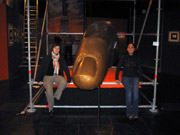| |
To break the monotony of this linear arrangement, partition walls are triangular and made in various sizes to give space more density and to guide the progression of the visitors through this construction designed and built on two continents.
The contrast of the modern contextual elements and the authenticity of the late 19th century sepia prints provides an original setting for the exhibited photographs.
First, at the entrance of this orange and gray room, in pride of place, the visitor will be fascinated by a full-sized plaster model of the statue's ear.Then he will come to two scale models, one showing how the original plaster model of the head was enlarged, the other illustrating the assembly of the beaten copper head. And next, a full-sized model of the index finger made of beaten copper will point the way to the dedication.
On the way out, a double digital view of one of the numerous replicas of the Statue of Liberty will invite the visitor to proceed to the Chapel of the Musée des arts et métiers, where the replica stands proudly, ending the diorama in front of the multicolored stained glass windows of the nave.
previous pages
1 - 2
- 3 pages
1 - 2
- 3 |
|

On the left, Marie-Sophie Corcy, commissioner
of the exhibition, and on the right, Nathalie Vu Hong,
scenographer and project manager.
© Musée des arts et métiers - F. Noyé |
|







